The search landscape has officially gone beyond blue links. Search for a product or topic, and you're more and more likely to get a conversational AI answer. Google AI Overviews (AIOs), ChatGPT, Perplexity, and other AI experiences are changing search behavior, so traditional SEO doesn't cut it anymore—you need to know if your brand appears in AI-generated answers.
This isn't yet another trend but a major step in search evolution. According to Statista, the number of U.S. searchers using AI as their main tool is expected to reach 36 million by 2028, compared to 15 million in 2024.
To make sure these millions of potential customers are finding your brand, you need to closely monitor your product and content mentions in AI answers. In this guide, I'll show you how to find the best tool that lets you do so effortlessly.
What you will learn
- What AI search visibility tracking is and why it matters
- How to evaluate the best AI search tracking tool
What is AI search?
AI search is the use of advanced AI technologies to understand natural language queries, rank results based on relevance, and improve search accuracy over time through machine learning. It goes beyond keyword-based searches by using natural language processing and machine learning to understand user intent and context, which leads to more relevant and personalized search results.
The results of AI searches differ from those we're used to. Instead of a simple list of results, you get conversational answers or AI snapshots built on top of search engines or chat-based experiences.
You might've noticed this if you've recently Googled pretty much anything. At the top of the SERPs, a conversational AIO is providing a clear answer to your question.
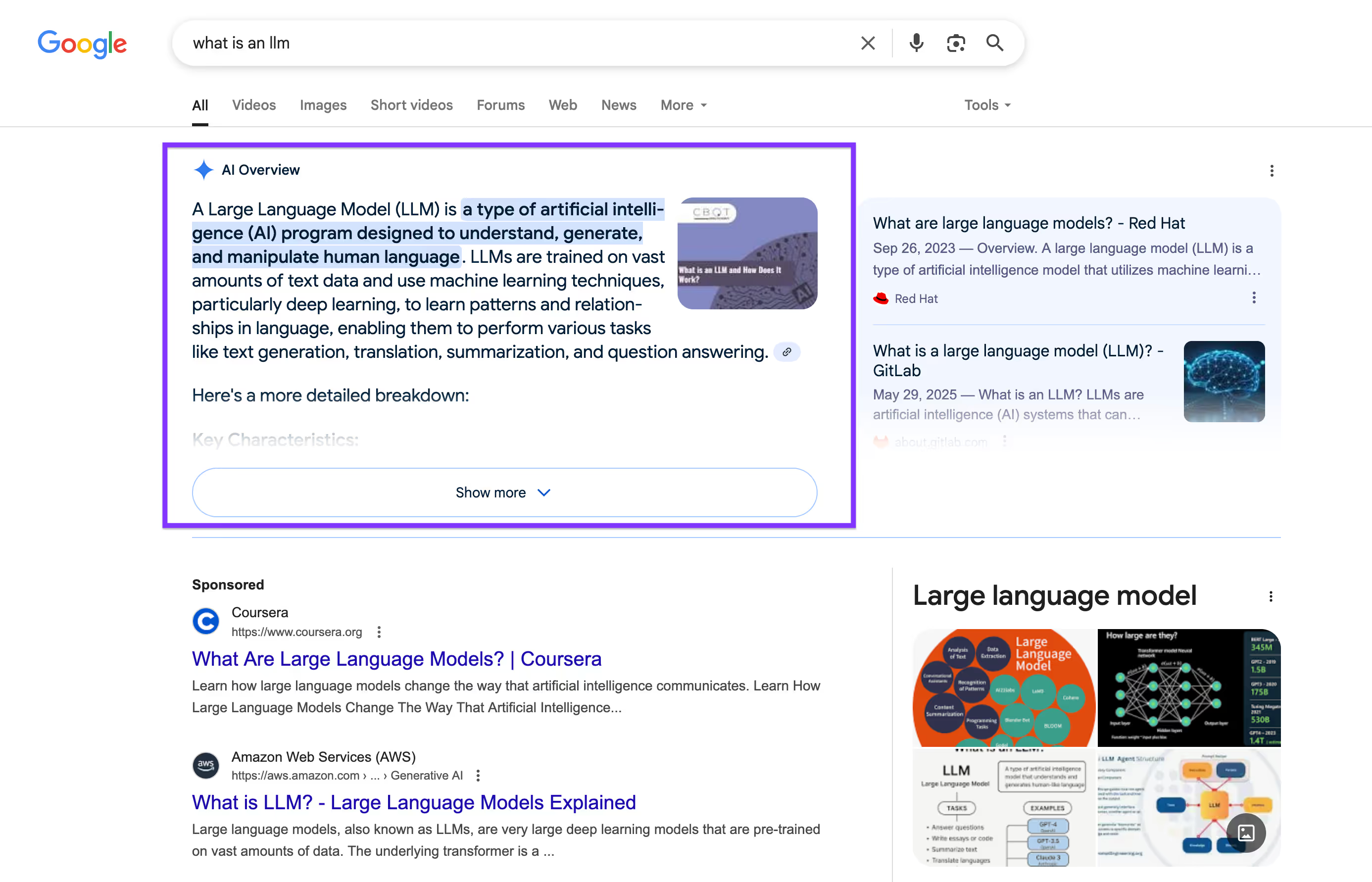
AIOs are one of the many implementations of AI search. People are now using various answer engines, such as:
- Google's AI mode
- ChatGPT
- Perplexity
- Meta AI
While these engines are changing search behavior, they shouldn't discourage you from optimizing your content. On the contrary, you can (and should) adapt your content to them because it can still be featured or cited.
For example, if you do a Perplexity search for "best noise-cancelling headphones," you'll see several links at the top:
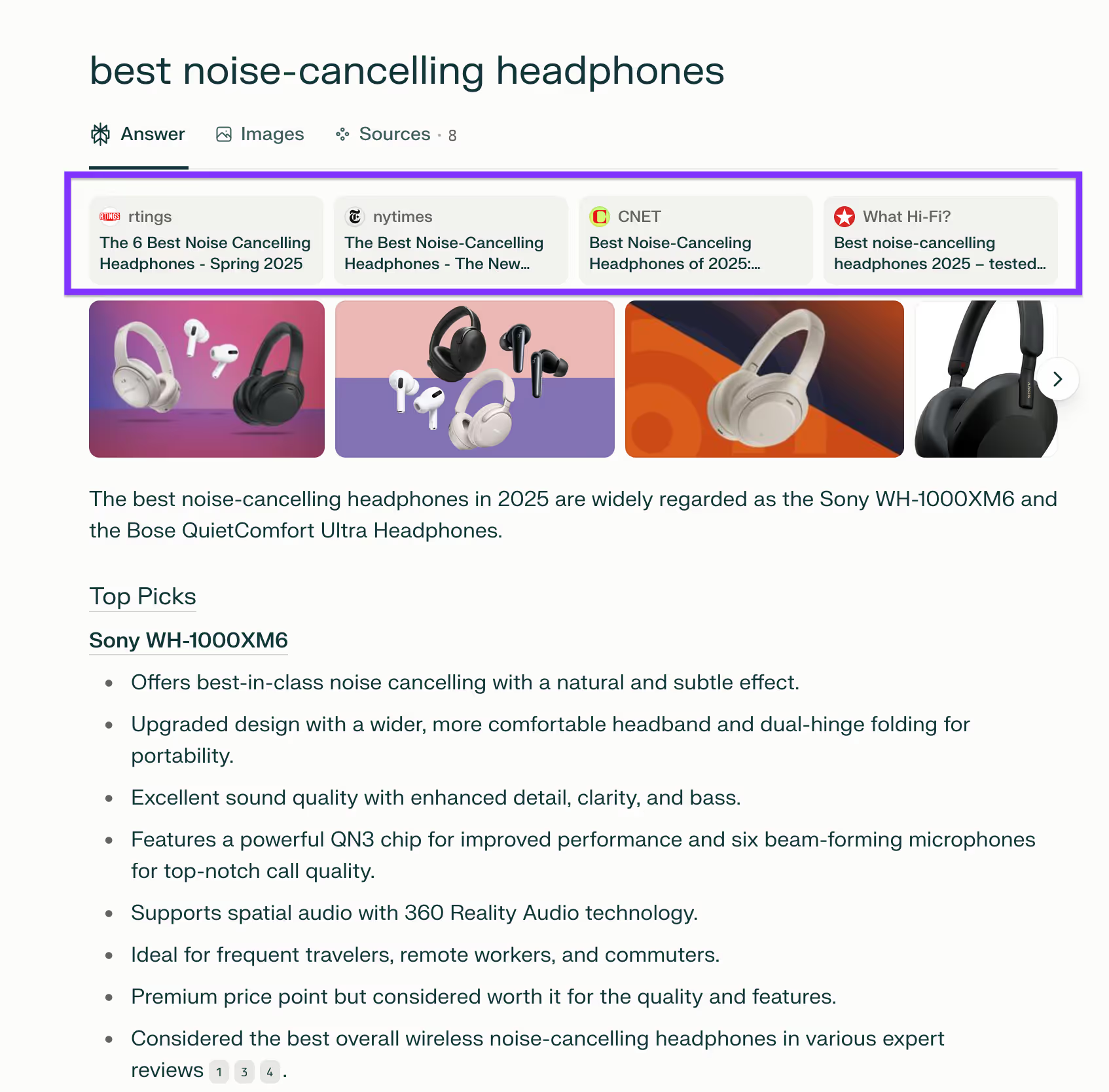
These sources are the most authoritative for the query, so Perplexity highlighted them much like Google does in traditional search.
If you go to the Sources section, you'll see several more links that Perplexity used to answer the question:
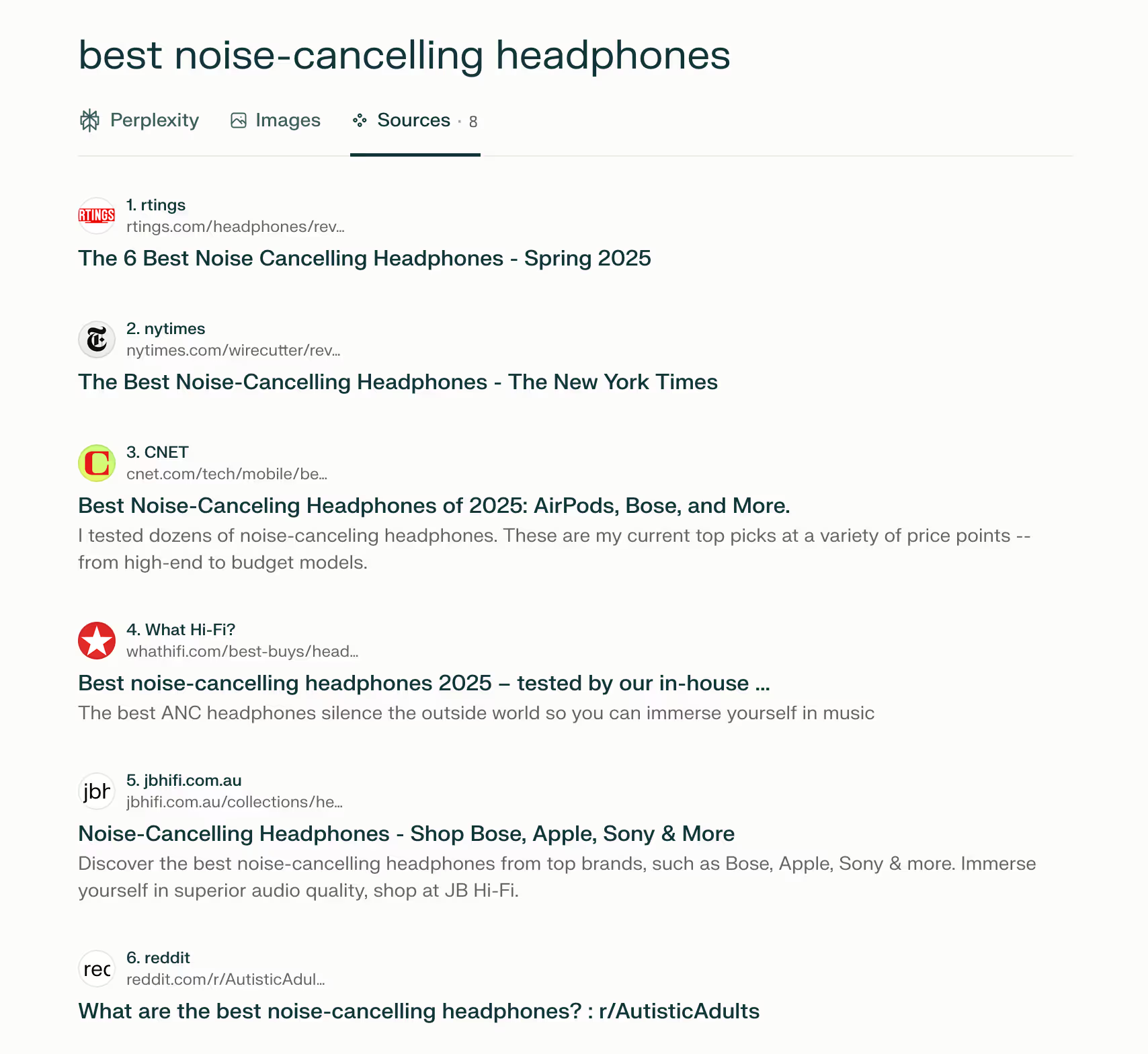
Each AI platform handles references differently, so they might come in the form of citations or traditional organic links. Either way, authoritative and well-optimized content is as important as ever.
Why is AI Search visibility important?
AI search visibility is important because it's the only way brands can ensure they remain discoverable, trusted, and competitive in the age of AI-generated answers.
As users change the way they search, your business must adapt and go beyond traditional SEO to account for AI search engines.
If you keep focusing on Google search alone, you risk losing traffic even if your content ranks high due to zero-click searches. As Google's AIOs answer questions before the user sees the top-ranking pages, many people don't click on any pages.
We're currently seeing a consistent rise in zero-click searches, and this isn't likely to change anytime soon.
Besides, people might not go to Google for their queries in the first place. With the increased use of AI platforms, Google is slowly but steadily losing its prime position.
In October 2024, its market share dipped below 90% for the first time in the last decade, and it's been decreasing over the past few months.
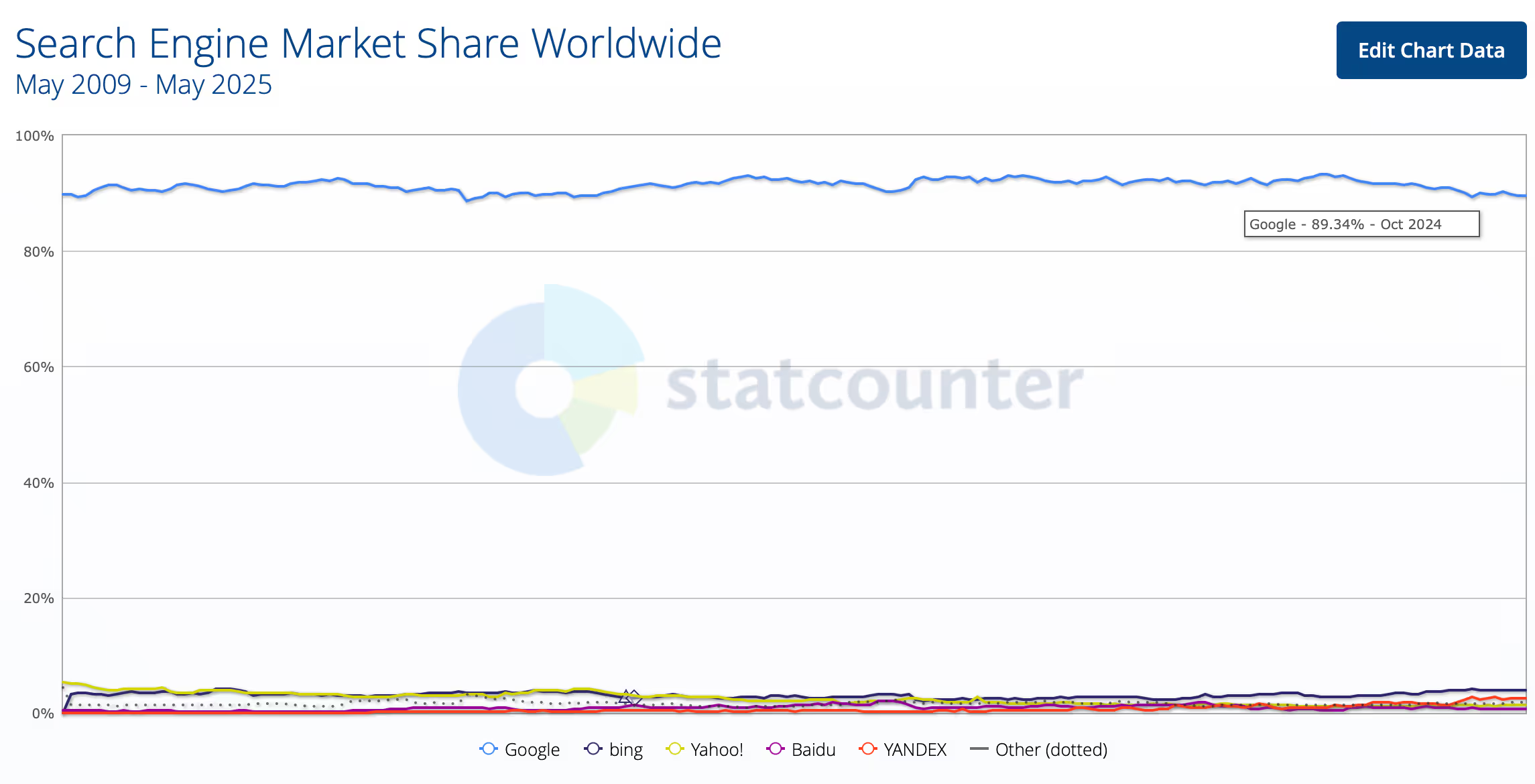
As the shift to AI search continues, brands must monitor whether they’re being mentioned, cited, or linked to in AI-generated content.
Without comprehensive tracking, you risk losing valuable traffic, leads, and even brand authority to the competitors that have started optimizing for AI engines.
For example, a brand like Lenovo will want to know if its laptops are being recommended by ChatGPT or Perplexity for commercial-intent queries (spoiler alert: it is).
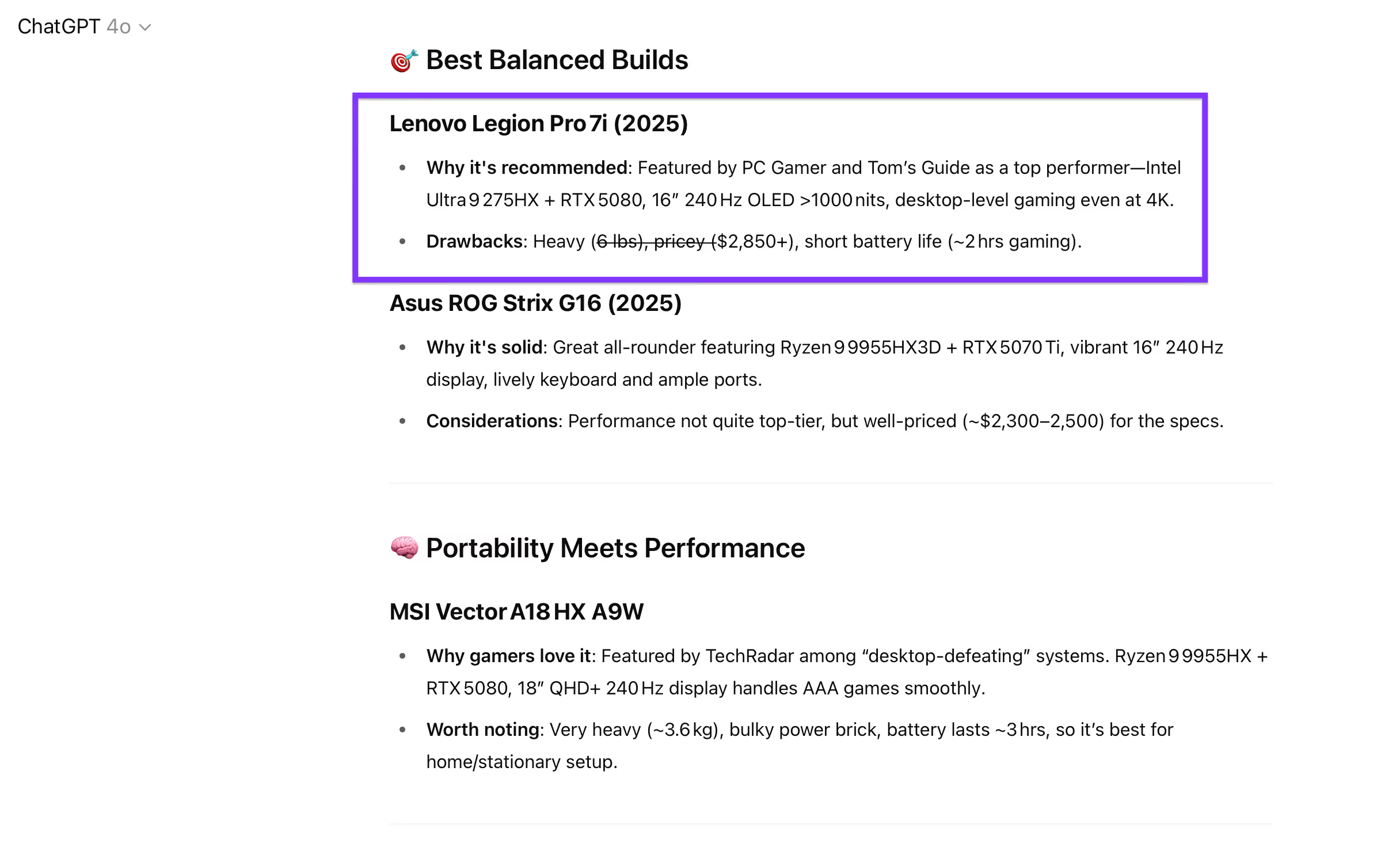
While performing an AI search can reveal if this is the case, you'll want a more efficient and data-driven method of tracking brand mentions in AI answers. Luckily, a solid AI visibility tool can take care of the heavy lifting.
7 features to look for in an AI search visibility tool
When choosing an AI search visibility tracking tool, focus on these features:
1. Tracks AI-generated citations across multiple platforms
If well-optimized, your content can show up in many AI platforms, not just Google's AI Overviews. That's why you need a tool that scours different answer engines for citations and mentions of your brand.
What should you look for in cross-platform AI tracking?
- Coverage of leading AI search engines like ChatGPT, Perplexity, and Google Gemini
- Detection of brand mentions, citations, and summaries in AI-generated answers
- Support for prompt-level tracking across generative platforms
2. AI visibility metrics or score
To ensure effective reporting, your AI visibility tool should quantify your content's performance through an AI visibility score.
What should you expect from AI visibility scoring?
- A proprietary score or ranking based on AI brand mentions and positioning
- Share of voice metrics specific to AI search environments
- Historical trendlines showing performance growth or decline
Your content can show up across platforms in different contexts and search types, which can make precise tracking more complicated.
An AI visibility score makes tracking more effortless by accounting for all the specifics of AI search and clearly assessing your content's performance.
Seeing as the AI score will likely reflect point-in-time performance, look for a tool that can monitor it over time. This way, you can start identifying patterns and change your content optimization strategy accordingly.
3. AI search optimization suggestions
As AI search is still a new concept, marketers are still figuring out how to optimize their content, and your visibility tracking tool should help you do it.
What optimization features should your AI visibility tracking tool offer?
- Analysis of source URLs used in AI responses for your target queries
- Recommendations to improve content structure for AI citation
- Detection of gaps in AI citations compared to traditional SEO
In short, look for tools that show why you’re ranking (or not) and offer actionable tips for AI answers, such as updating FAQs, adding schema, or improving answerability on your pages.
4. Traffic insights
Better AI visibility means more traffic. But the question is, how much more?
You can't predict or even ballpark a figure on your own, so your AI visibility tracker should help out. It should outline the impact of visibility on website visits so that you can see the tangible value of showing up in AI search results.
What AI traffic insights should you track?
- Referral data from AI tools when available (e.g., browser-based bots, plugin usage)
- Estimations of traffic potential based on citation prominence
- AI-specific traffic segmentation from organic visits
5. Monitoring traditional organic and AI-search visibility
Despite the AI boom, Google isn't going anywhere—the blue link economy is very much alive, and your traditional SEO strategy still matters.
You should track it alongside AI visibility to monitor the evolution of your traffic sources and adjust your strategy accordingly.
Even if you already have a comprehensive SEO monitoring toolset, it's best if your AI visibility tracking platform provides the related insights. Think of it as the hybrid monitoring of both traditional SEO and AI performance.
What features should a tracker offer for hybrid visibility?
- Side-by-side reporting of keyword rankings and AI-generated citations
- Filters to compare performance across AI platforms vs. traditional search engines
- Unified dashboards combining SEO and AI visibility metrics for easy trend analysis
6. Competitor tracking
Seeing where you stand in AI answer engines isn't enough, so you should also understand your competitive positioning.
In other words, you need to know if other brands and products appear in AI answers more than yours and why this is the case.
What should competitor AI visibility tracking include?
- Share of voice comparisons across major AI platforms
- Visibility alerts when competitors gain ground in AI responses
- Benchmarking tools to spot visibility gaps and opportunities
7. Trend identification
Search behavior is shifting fast. AI visibility platforms must help you stay ahead by identifying emerging prompts, trending industry queries, and shifts in how topics are being represented in generative answers.
What should AI trend detection include?
- AI prompt monitoring to spot new topic clusters
- Trend alerts when new sources or formats dominate AI results
- Early identification of shifts in AI citation behavior across platforms
7 popular tools for AI visibility tracking
If you still haven't explored AI visibility tools, here are some options worth trying out:
1. Surfer
Surfer has recently launched an AI visibility tool with a suite of features designed to help content teams monitor how their pages perform not only in traditional Google Search but also in AI search platforms.
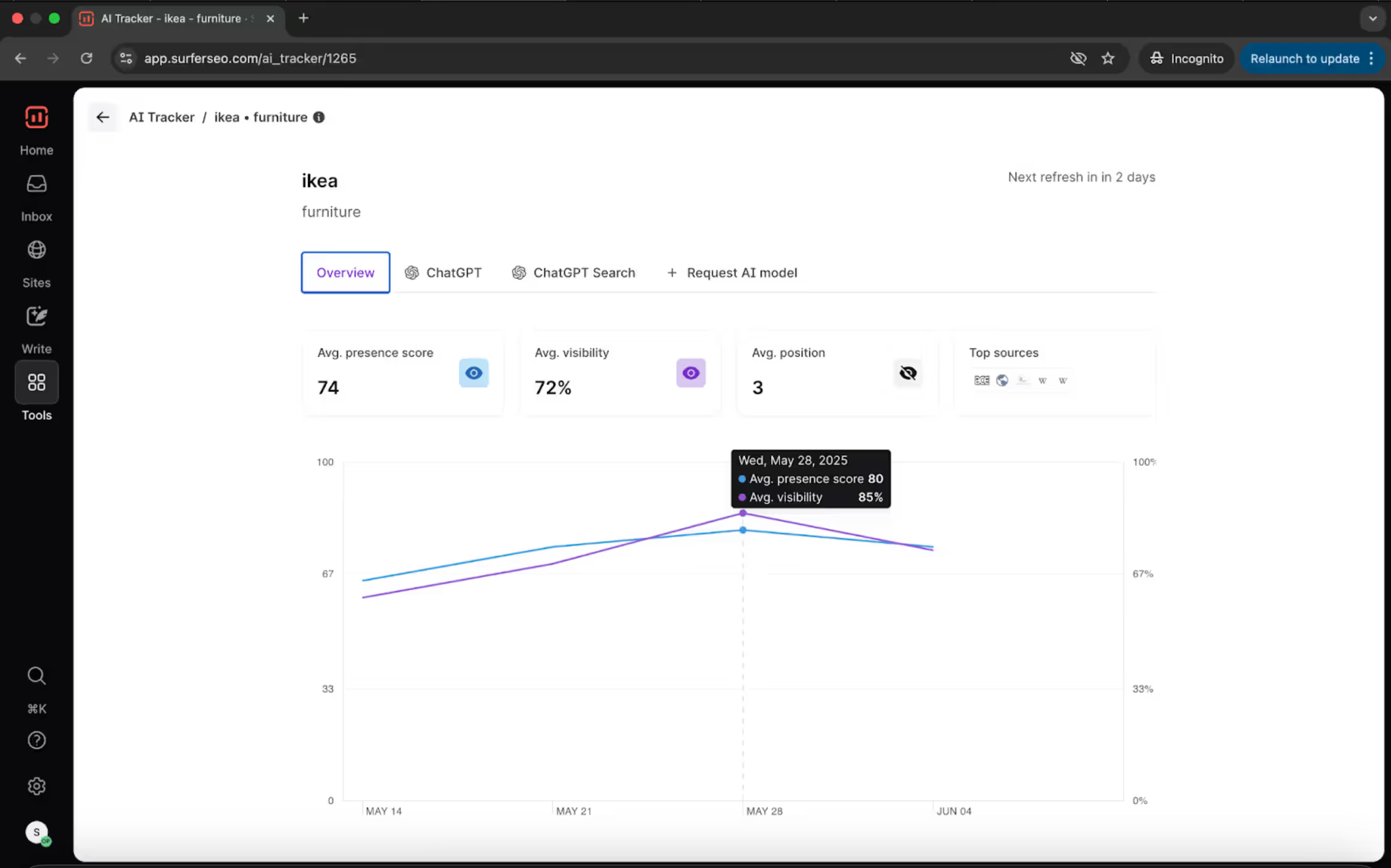
What sets Surfer apart is how it integrates both SEO optimization and AI content tracking into one unified workflow. Users can optimize pages, then track whether those pages appear in AI engines, within the same dashboard.
For example, a SaaS content team is optimizing their product pages for terms like “best email warm-up tools” or “AI SDR platform.”
Using Surfer, they can build keyword-optimized content that ranks in traditional SERPs, and monitor if their pages are featured in Google’s AIO summaries and ChatGPT answers, ensuring visibility across both search formats.
2. Profound
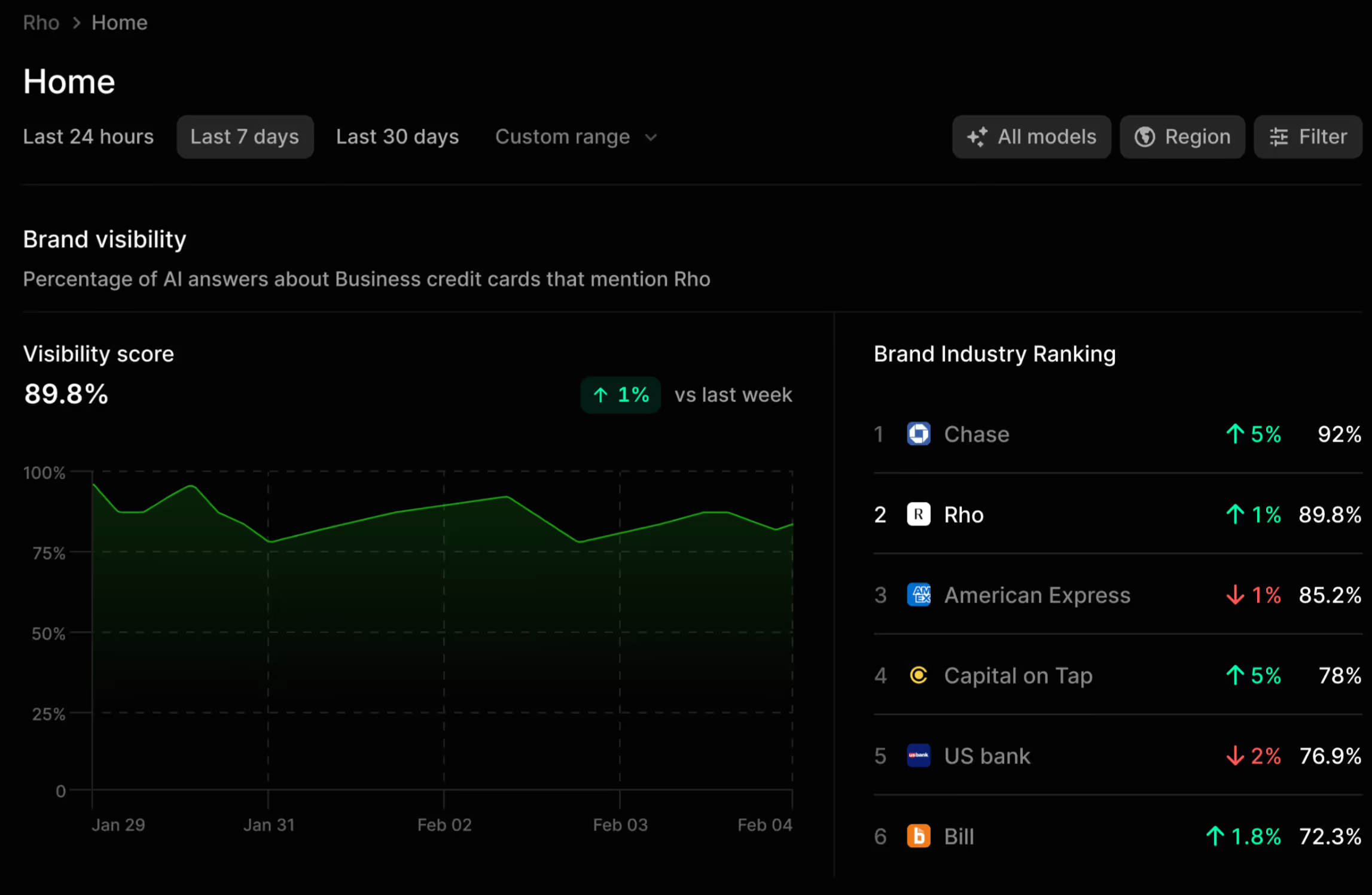
Profound is an enterprise-grade AI search tracking platform mainly aimed at large brands. It offers a comprehensive dataset for AI results, covering platforms like:
- Google’s AI Overviews
- ChatGPT
- Microsoft Copilot
- Perplexity
Unlike basic rank trackers, Profound automates topic clustering and citation tracking, so it instantly groups related prompts and shows which sources the AI is quoting. It also highlights where competitors are gaining AI visibility and even suggests keyword or entity optimizations.
The end result is a comprehensive view—not just if your brand appears, but on which AI platforms and for which questions.
3. Semrush's AI Toolkit
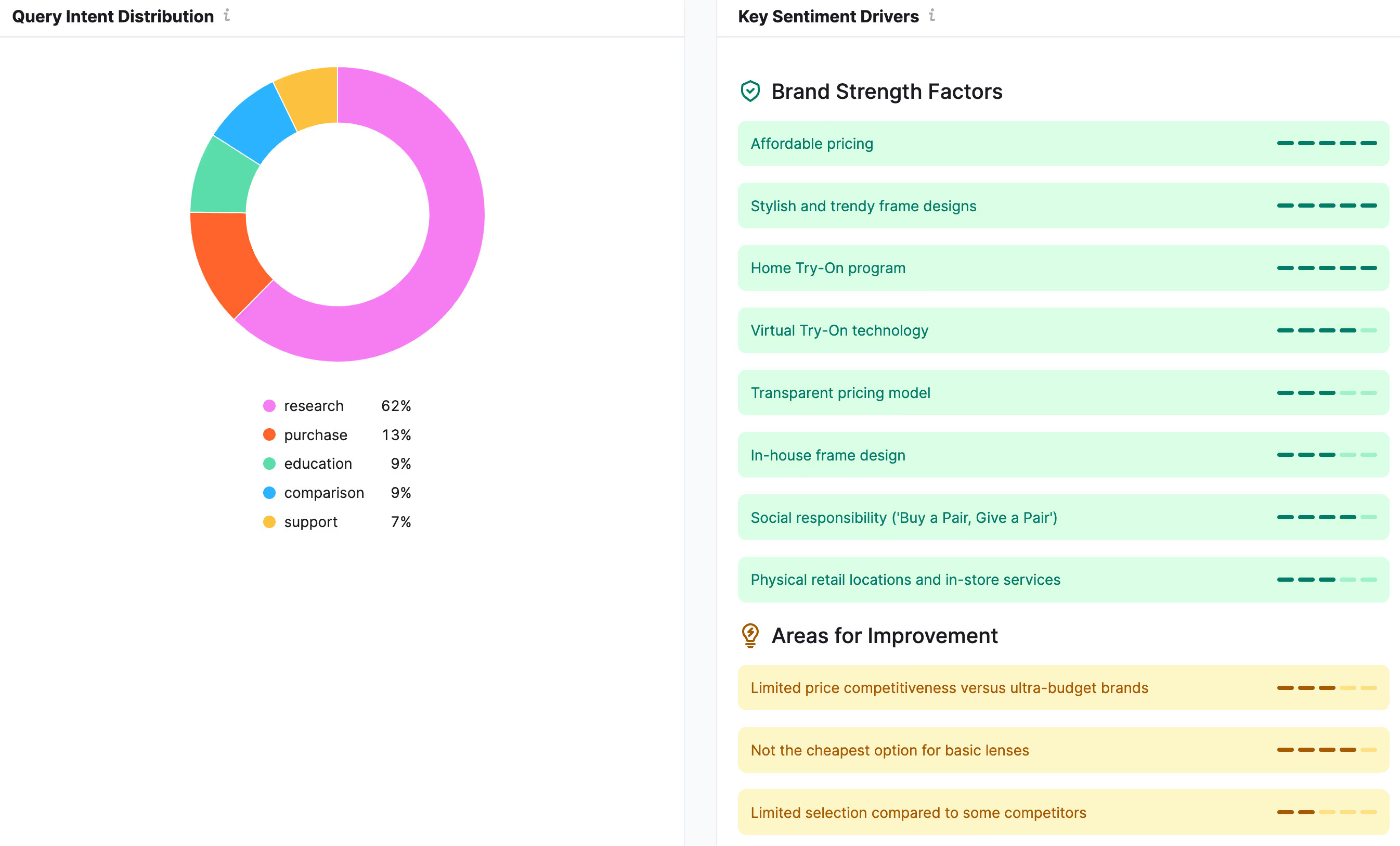
Semrush’s AI Toolkit is an add-on to the popular SEO platform that gives marketers high-level insights into their AI presence. Instead of tracking individual keyword prompts, it provides domain-level indicators like:
- AI-driven sentiment
- Engagement
- An overall visibility metric
The tool's unique feature is that it shows whether your site and content are resonating with AI-generated content. For example, Semrush’s AI report might note if your brand is frequently mentioned by chatbots or how positively AI answers describe you.
It’s not as granular as some specialized tools, but it’s handy for existing Semrush users to check if their SEO efforts are registering in AI answers.
4. Nightwatch
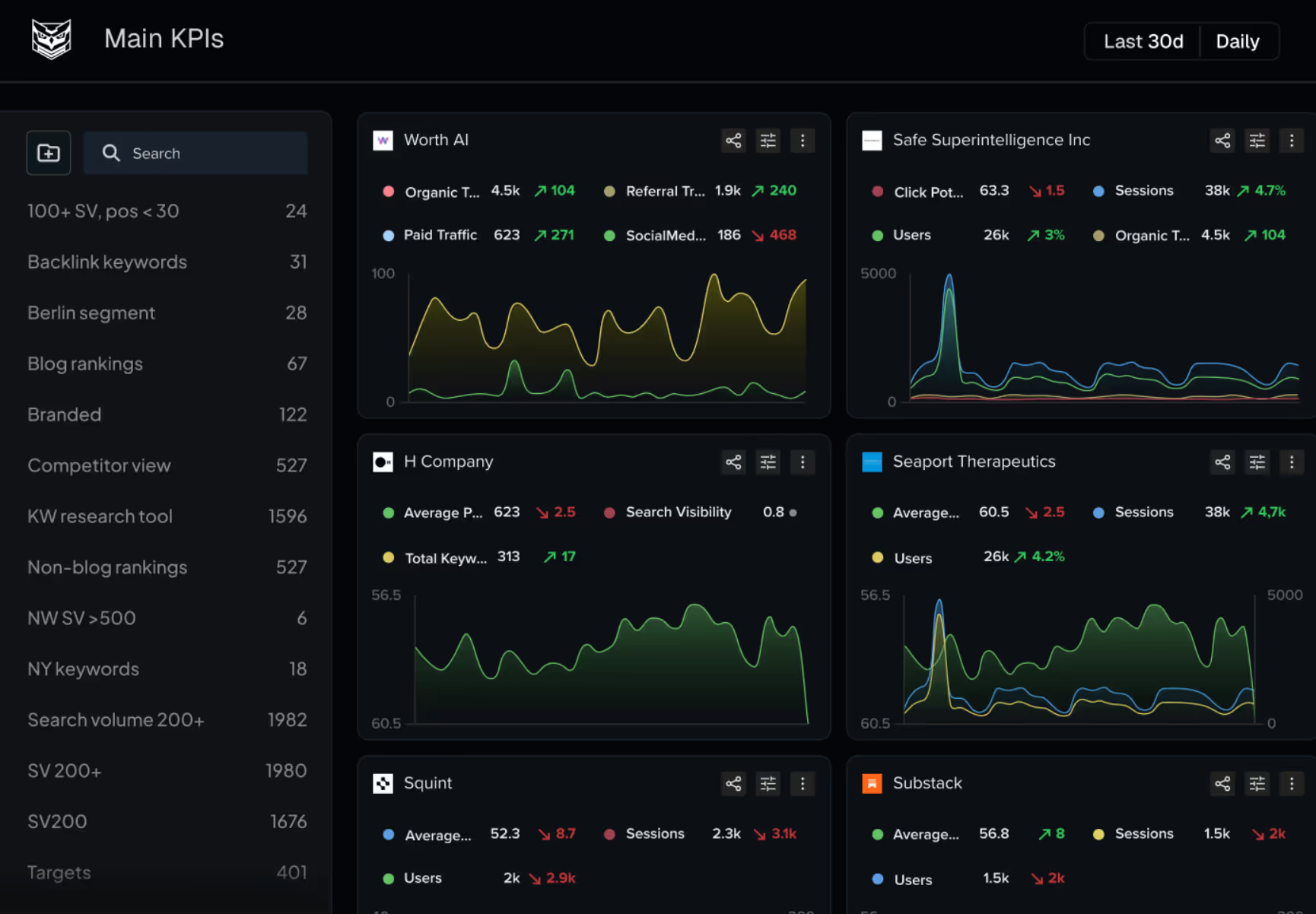
Nightwatch started out as a traditional rank tracking platform that now offers dedicated LLM and AI features. Its new LLM Keyword Tracking (which is currently in beta) lets you follow keyword positions on ChatGPT (3.0/4.0) and Claude AI models alongside Google and Bing. In other words, you can see where your keywords “rank” in ChatGPT’s knowledge.
Nightwatch also introduced AI Overview tracking, which automatically flags if your site appears in Google’s AIO.
The tool even shows which pages users reached via AI prompts by tracking popular phrases and questions people ask to get your content, so you can see which pages get the most traffic from AI systems.
If you leverage all of its features, Nightwatch lets you compare traditional SEO ranks and AI ranks in one interface, with special focus on the new AI-driven features.
5. SE Ranking
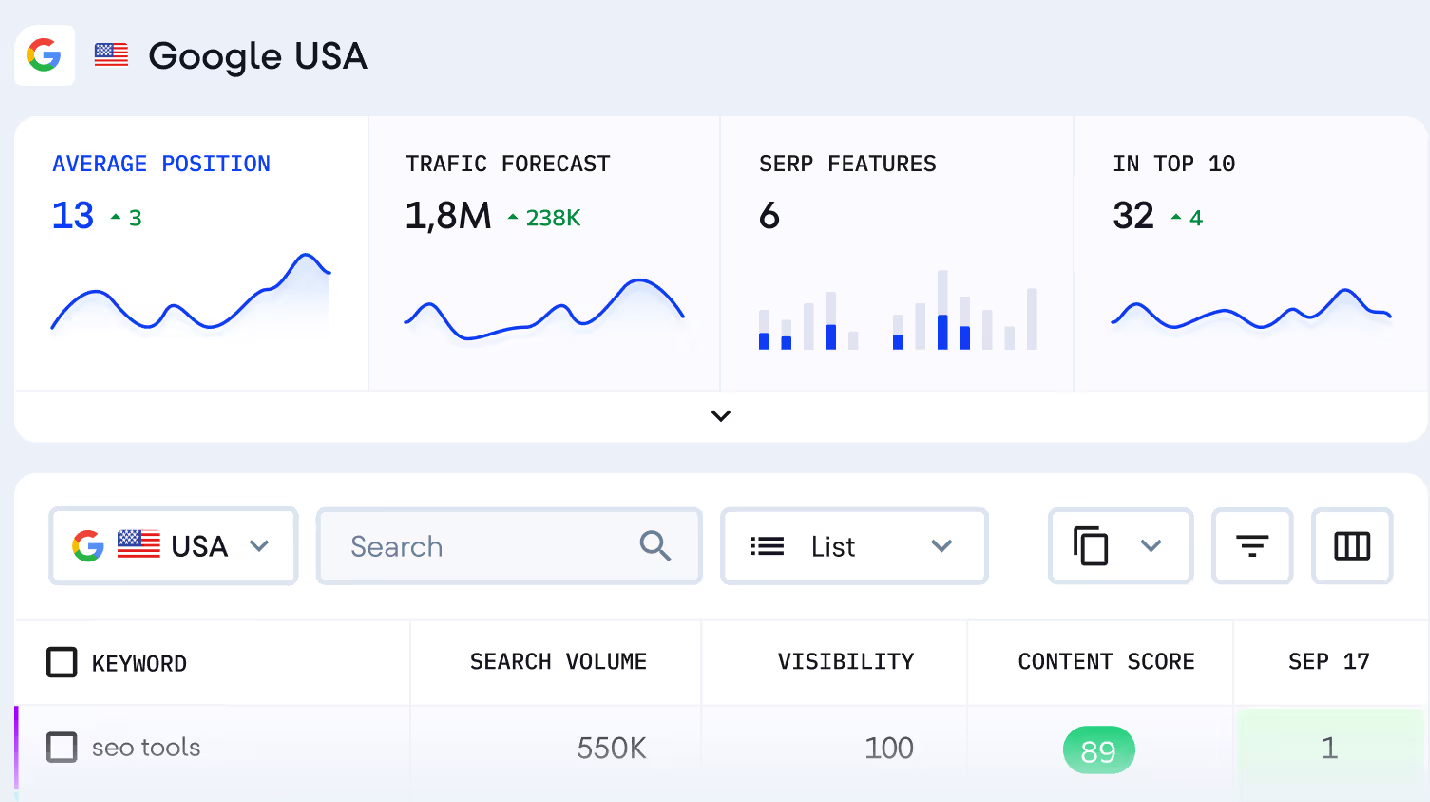
SE Ranking is an all-in-one SEO suite, and its new AI Visibility Tracker (currently in beta) focuses on brand mentions in AI answers. It monitors AI responses from ChatGPT, Google AI Overviews, and other bots to see when, where, and how your brand is mentioned.
The platform tracks if your site’s pages are linked to or mentioned, and even identifies which prompts trigger those mentions.
SE Ranking puts quite a bit of focus on competitive analysis—you can do side-by-side comparisons of your AI visibility versus other sites in your niche. It also provides a timeline of your AI visibility over time, letting you spot notable trends.
All in all, SE Ranking’s AI feature works like an automated brand-monitoring tool for AI search, highlighting missed opportunities and competitor strengths
6. seoClarity (Clarity ArcAI)
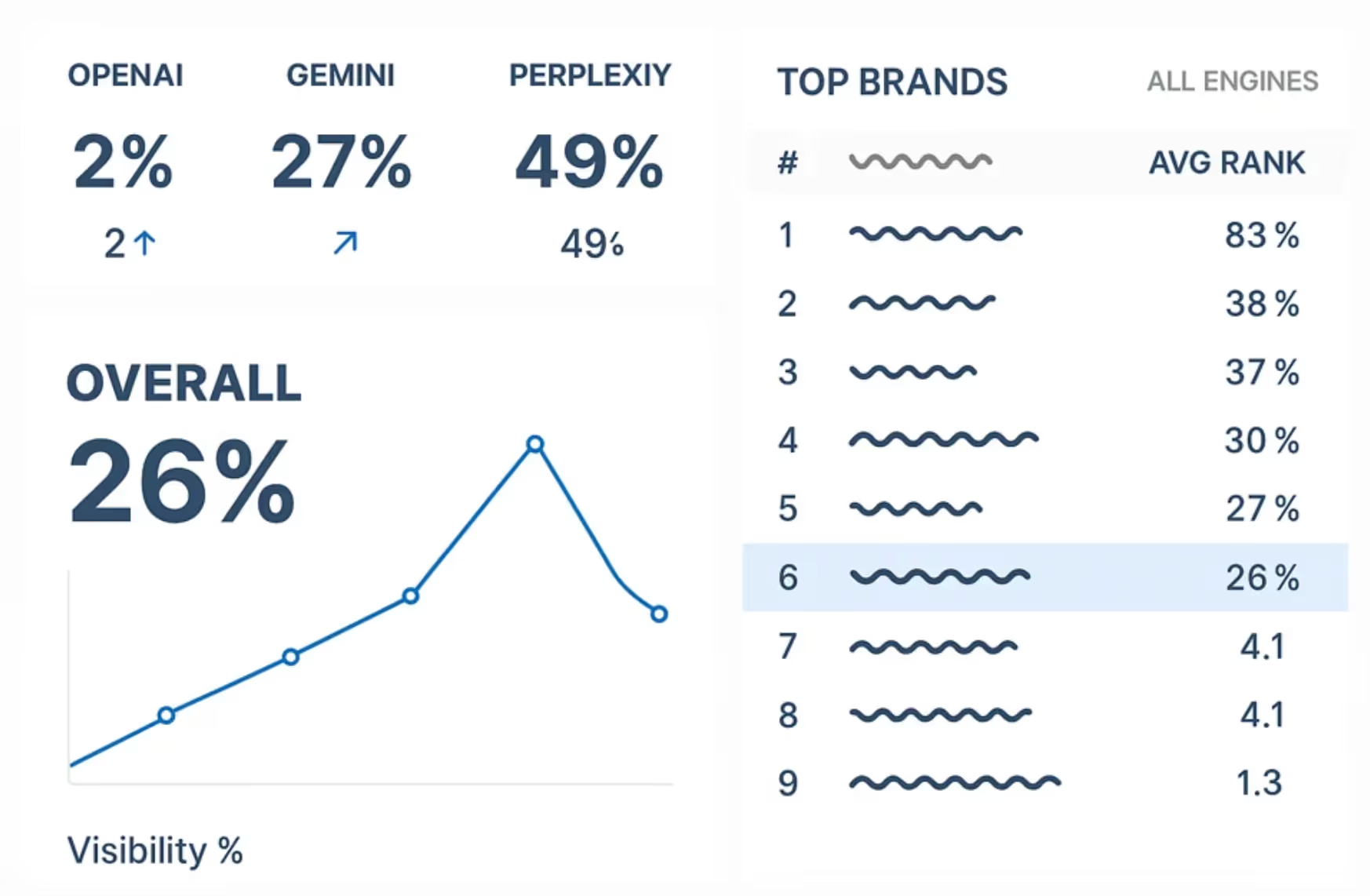
Similar to Profound, seoClarity’s Clarity ArcAI is an AI search optimization platform for enterprise users. It generates thousands of AI-style search prompts across your key topics and tells you how often and where your brand shows up (versus competitors).
The tool also highlights gaps in your strategy by showing you the niche queries where the AI answers bypass you entirely.
More importantly, seoClarity offers AI content recommendations to help you fill those gaps. It also includes real-time citation tracking, listing which sources the AI is quoting in your industry.
7. Similarweb
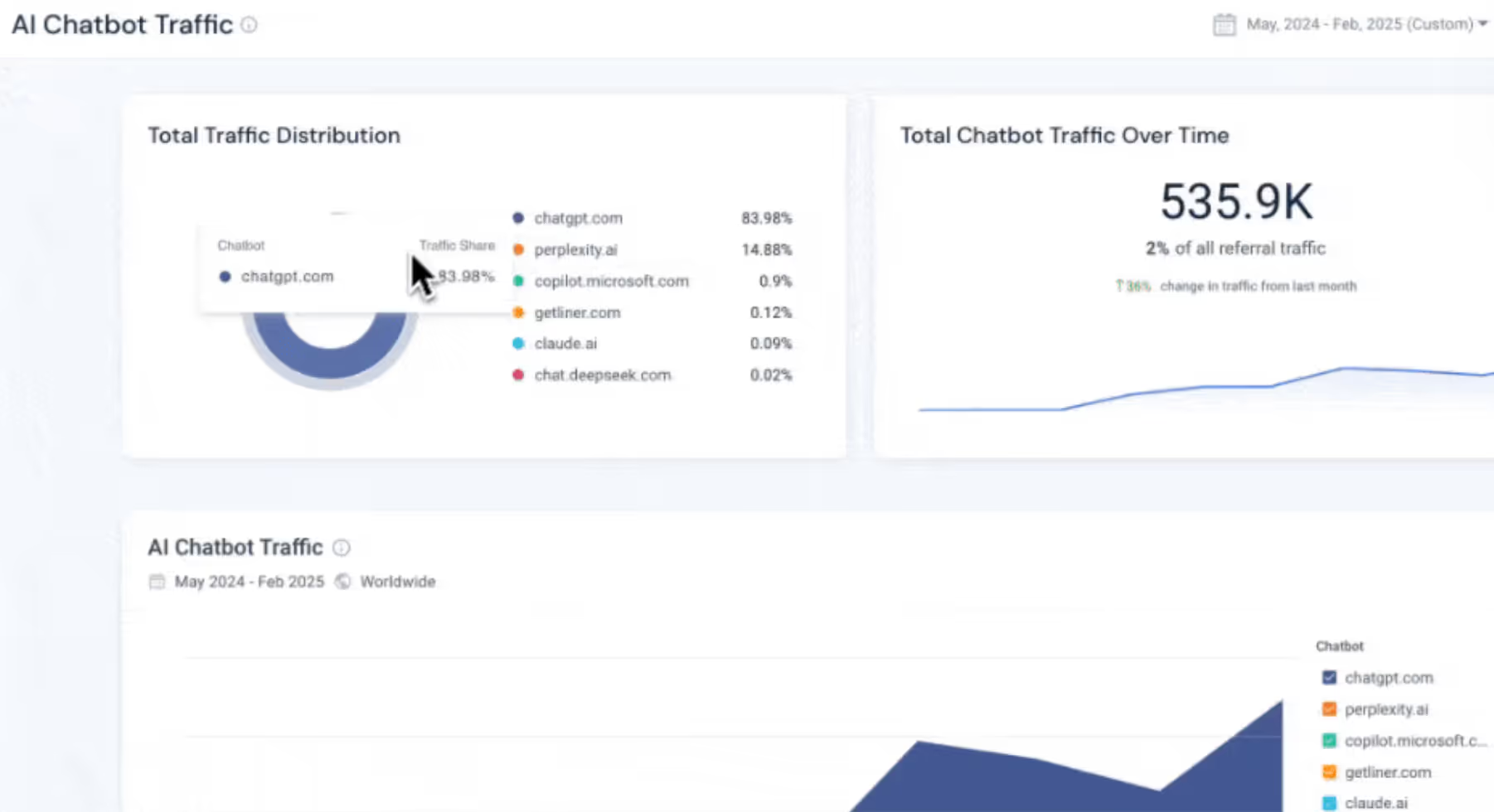
Similarweb is a well-known traffic analytics platform, which recently added a few AI-focused features like the AI Chatbot Traffic tracking tool. It treats visits from chatbots as a new referral source, directly connecting AI visibility to more tangible metrics like the traffic volume.
The dashboard shows how much web traffic is driven by AI tools (ChatGPT, Perplexity, etc.) and which of your pages get the most AI referrals.
It even lists the exact prompts that directed users to each page. For example, you might see that asking “show me affordable running shoes” in ChatGPT sent visitors to your product page.
By surfacing this data, Similarweb helps SEO pros quantify the impact of AI discovery and optimize their for top chatbot queries.
Key takeaways
- AI search is the use of technologies like ML and NLP to understand and process natural language queries and return an answer in the form of conversational text instead of plain link-based results.
- AI-generated responses are getting increasingly popular, so you must track the visibility of your brand in them to go beyond traditional SEO and optimize your content for AI search tools.
- To track brand mentions and citations in AI responses, you need a capable tool that examines different answer engines and shows how often your content and/or products appear in them (alongside other useful information like the overall sentiment toward your brand).
- Make sure your chosen tool can analyze multiple AI search solutions for a high-level overview of your presence. At the very least, the tool should cover major platforms like ChatGPT, Perplexity, Claude, and Google's AI Overviews.
- AI visibility is harder to quantify than traditional SERP performance, so your tool should offer a visibility score that will encompass your brand presence and let you track it over time.
- Traditional SEO is far from gone, so you should compare your SEO strategy to your AI optimization efforts side by side. Look for a tool that lets you do this in a unified dashboard.
- Competitive benchmarking is crucial for positioning yourself well in AI search, so look for a tool that lets you compare your performance to direct competitors.




